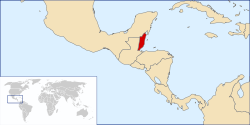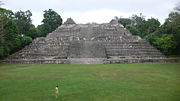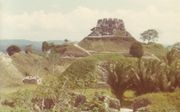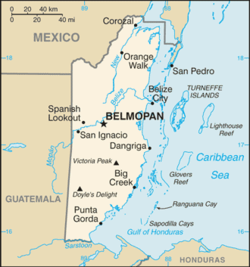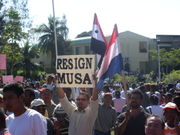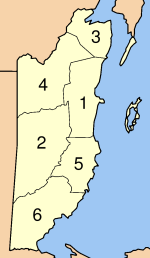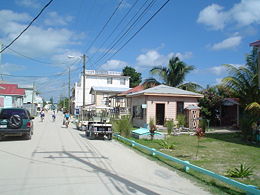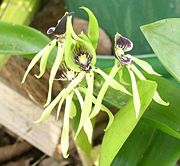Belize
2008/9 Schools Wikipedia Selection. Related subjects: Americas; Countries
|
Belize
|
||||||
|---|---|---|---|---|---|---|
|
||||||
| Motto: Sub Umbra Floreo (Latin) "Under the Shade I Flourish" |
||||||
| Anthem: " Land of the Free" Royal anthem: " God Save the Queen" |
||||||
|
|
||||||
| Capital | Belmopan |
|||||
| Largest city | Belize City | |||||
| Official languages | English (official) | |||||
| Recognised regional languages | Kriol, Spanish | |||||
| Demonym | Belizean | |||||
| Government | Parliamentary democracy and Constitutional monarchy | |||||
| - | Monarch | Elizabeth II | ||||
| - | Governor-General | Sir Colville Young | ||||
| - | Prime Minister | Dean Barrow | ||||
| Independence | from the United Kingdom | |||||
| - | Date | September 21, 1981 | ||||
| Area | ||||||
| - | Total | 22,966 km² ( 150th) 8,867 sq mi |
||||
| - | Water (%) | 0.7 | ||||
| Population | ||||||
| - | (July 2008 est.) estimate | 301,270 ( 173rd²) | ||||
| - | Density | 13/km² ( 202nd²) 34/sq mi |
||||
| GDP ( PPP) | 2006 estimate | |||||
| - | Total | $2.098 billion ( 163rd) | ||||
| - | Per capita | $8,400 ( 76th) | ||||
| HDI (2007) | ▲0.777 (medium) ( 80th) | |||||
| Currency | Dollar ( BZD) |
|||||
| Time zone | central time ( UTC-6) | |||||
| Internet TLD | .bz | |||||
| Calling code | +501 | |||||
| 1 | These ranks are based on the 2007 figures. | |||||
Belize (pronounced /bəˈliːz/), formerly British Honduras, is a country in Central America. Once part of the Mayan and Spanish empires, it was most recently a British colony, gaining its independence in 1981. The country is bordered to the south and west by Guatemala, to the north by Mexico, and to the east by the Caribbean Sea.
Belize has a diverse society, composed of many cultures and speaking many languages; it is the only country in Central America where English is an official language, and both Spanish and Kriol are also widely spoken. With 8,867 square miles (22,960 km²) of territory and 301,270 people (2008 est.), the population density is the lowest in the Central American region and one of the lowest in the world. The country's growth rate, 2.207% (2008 est.), is the highest in region and one of the highest in the western hemisphere.
History
The origin of the name Belize is unclear, but one idea is that the name is from the Maya word belix, meaning "muddy water," applied to the Belize River. Before the arrival of Europeans, Belize was part of the territory of the Maya. The Mopan Maya were the original inhabitants of Belize. The Maya civilization spread itself over Belize beginning around 1500 BC and flourished until about AD 900. In the late classic period of Maya civilization (before ad 1000), as many as 400,000 people may have lived in the area that is now Belize. Some lowland Maya still occupied the area when Europeans arrived in the 1500s. Spanish colonists tried to settle the inland areas of Belize, but they abandoned these efforts following Maya rebellion against Spanish authority.
English buccaneers first settled on the coast of Belize in 1638, seeking a sheltered region from which they could attack Spanish ships. The settlers turned to cutting logwood during the 1700s. The wood yielded a fixing agent for clothing dyes that was vital to the European woolen industry. The Spanish granted the British settlers the right to occupy the area and cut logwood in exchange for an end to piracy. Historical accounts from the early 1700s note that Africans were brought to the settlement from Jamaica to work as slaves and cut timber. As early as 1800 Africans outnumbered Europeans by about four to one. By then the settlement’s primary export had shifted from logwood to mahogany.
For fear of provoking Spanish attack, the British government did not initially recognize the settlement in Belize as a colony. It allowed the settlers to establish their own laws and forms of government. During this time a few wealthy settlers gained control of the local legislature, known as the Public Meeting, as well as of most of the settlement’s land and timber. The British first appointed a superintendent over the area in 1786.
The Spanish, who claimed sovereignty over the whole of Central America, tried often to gain control by force over Belize, but they were not successful. Spain’s last attack ended on September 10, 1798, when the people of Belize decisively defeated a Spanish fleet at the Battle of St. George’s Cay. The anniversary of the battle is now a national holiday in Belize.
In the early 1800s the British sought greater control over the settlers, threatening to suspend the Public Meeting unless it observed the government’s instructions to abolish slavery. Slavery was abolished in the British Empire in 1838, but this did little to change working conditions for laborers in the Belize settlement. Because a small elite controlled the settlement’s land and commerce, former slaves had no choice but to continue to work in timber cutting.
In 1836, after the emancipation of Central America from Spanish rule, the British claimed the right to administer the region. In 1862 Great Britain formally declared it a British colony, subordinate to Jamaica, and named it British Honduras. As a colony Belize began to attract British investors. Among the British firms that dominated the colony in the late 1800s was the Belize Estate and Produce Company, which eventually acquired half of all the privately held land in the colony. Belize Estate’s influence accounts in part for the colony’s reliance on the mahogany trade throughout the rest of the 19th century and the first half of the 20th century.
The Great Depression of the 1930s caused a near-collapse of the colonial economy as British demand for timber plummeted. The effects of widespread unemployment were worsened by a devastating hurricane that struck the colony in 1931. Perceptions of the government’s relief effort as inadequate were aggravated by its refusal to legalize labor unions or introduce a minimum wage. Demonstrations and riots in 1934 marked the beginning of an independence movement. In response, the government repealed criminal penalties for workers who broke their labor contracts and granted workers the right to join unions.
Economic conditions improved during World War II (1939-1945), when many Belizean men entered the armed forces or otherwise contributed labor to the war effort. Following the war the colony’s economy again stagnated. Britain’s decision to devalue the British Honduras dollar in 1949 worsened economic conditions and led to the creation of the People’s Committee, which demanded independence. The People’s Committee’s successor, the People’s United Party (PUP), sought constitutional reforms that would expand voting rights to all adults.
Constitutional reforms were initiated in 1954 and resulted in a new constitution ten years later. Britain granted British Honduras self-government in 1964, and the head of the PUP—independence leader George Price—became the colony’s prime minister. British Honduras was officially renamed Belize in 1973. Progress toward independence, however, was hampered by an old Guatemalan claim to sovereignty over the territory of Belize. When Belize finally attained full independence on September 21, 1981, Guatemala refused to recognize the new nation. About 1,500 British troops remained to protect Belize from the Guatemalan threat.
With Price at the helm, the PUP won all elections until 1984. In that election, first national election after independence, the PUP was defeated by the United Democratic Party (UDP), and UDP leader Manuel Esquivel replaced Price as prime minister. Price returned to power after elections in 1989. Guatemala’s president formally recognized Belize’s independence in 1992. The following year the United Kingdom announced that it would end its military involvement in Belize. All British soldiers were withdrawn in 1994, apart from a small contingent of troops who remained to train Belizean troops.
The UDP regained power in the 1993 national election, and Esquivel became prime minister for a second time. Soon afterward Esquivel announced the suspension of a pact reached with Guatemala during Price’s tenure, claiming Price had made too many concessions in order to gain Guatemalan recognition. The pact would have resolved a 130-year-old border dispute between the two countries. Border tensions continued into the early 2000s, although the two countries cooperated in other areas.
The PUP won a landslide victory in the 1998 national elections, and PUP leader Said Musa was sworn in as prime minister. In the 2003 elections the PUP maintained its majority, and Musa continued as prime minister. He pledged to improve conditions in the underdeveloped and largely inaccessible southern part of Belize.
Throughout Belize's history, Guatemala has claimed ownership of all or part of the territory. This claim is occasionally reflected in maps showing Belize as Guatemala's twenty-third province. As of March 2007, the border dispute with Guatemala remains unresolved and quite contentious; at various times the issue has required mediation by the United Kingdom, Caribbean Community heads of Government, the Organisation of American States, and the United States. Since independence, a British garrison has been retained in Belize at the request of the Belizean government. Notably, both Guatemala and Belize are participating in the confidence-building measures approved by the OAS, including the Guatemala-Belize Language Exchange Project.
In 2005, Belize was the site of unrest caused by discontent with the People's United Party government, including tax increases in the national budget. On February 8, 2008, Dean Barrow was sworn in as Belize's first black prime minister.
Geography
The north of Belize consists mostly of flat, swampy coastal plains, in places heavily forested. The flora is highly diverse considering the small geographical area. The south contains the low mountain range of the Maya Mountains. The highest point in Belize is Doyle's Delight at 3,688 ft. (1,124 m.). The Caribbean coast is lined with a coral reef and some 450 islets and islands known locally as cayes (pronounced "keys"), forming the approximately 200 mile (322 km) long Belize Barrier Reef, the longest in the Western Hemisphere and the second longest in the world after the Great Barrier Reef. Three of the four coral atolls in the Western Hemisphere are also located off the coast of Belize. Belize is also the only Central American country without a coast on the Pacific Ocean.
The climate is tropical and generally very hot and humid. The rainy season lasts from June to November and hurricanes and floods are frequent natural hazards.
According to the most recent vegetation surveys, about sixty percent (60%) of Belize is forested, with only about twenty percent (20%) of the country's land subject to human uses (such as agricultural land and human settlements). Savanna, scrubland and wetland constitute extensive parts of the land. As a result, Belize's biodiversity is rich, both marine and terrestrial, with a host of flora and fauna. About thirty-seven percent (37%) of Belize's land territory falls under some form of official protected status.
Politics
Belize is a parliamentary democracy, or a constitutional monarchy and a member of the Commonwealth of Nations.
The structure of government is based on the British parliamentary system, and the legal system is modeled on the common law of England. The current head of state is the Queen of Belize, Elizabeth II, who is represented in the country by the Governor-General. However, the cabinet, led by a prime minister, who is head of government, acting as advisors to the Governor-General, in practice exercise executive authority. Cabinet ministers are members of the majority political party in parliament and usually hold elected seats within it concurrent with their cabinet positions.
The bicameral National Assembly of Belize is composed of a House of Representatives and a Senate. The twenty-nine members of the House are popularly elected to a maximum five-year term and introduce legislation affecting the development of Belize. The Governor-General appoints the twelve members of the Senate, with a Senate president selected by the members. The Senate is responsible for debating and approving bills passed by the House.
Belize is a full participating member of the Caribbean Community (CARICOM).
Districts and constituencies
Belize is divided into 6 districts:
- Belize District
- Cayo District
- Corozal District
- Orange Walk District
- Stann Creek District
- Toledo District
These districts are further divided into 31 constituencies.
Demographics
Colonisation, slavery, and immigration have played major roles in affecting the ethnic composition of the population and as a result, Belize is a country with numerous cultures, languages, and ethnic groups. According to the latest census, the country's population is a little over 300,000.
The Mayan are thought to have been in Belize and the Yucatán region since the 500s AD; however, much of Belize's original Maya population was wiped out by disease and conflicts between tribes and with Europeans. Three Maya groups now inhabit the country: Yucatecs (who came from Yucatán, Mexico to escape the Caste War), Mopans (indigenous to Belize but were forced out by the British; they returned from Guatemala to evade slavery), and Kekchi (also fled from slavery in Guatemala).
White, initially Spanish and later English and Scottish, settlers entered the area in the 15th and 16th century respectively. The first African slaves began arriving from elsewhere in the Caribbean and began intermarrying with many of the other ethnic groups in the country. Intermingling with whites was not common; however, this mixture created the Belizean Kriol people ethnic group. After 1800, Mestizo settlers from Mexico and Guatemala began to settle in the north; the Garifuna, a mix of African, Arawak, and Carib ancestry, settled in the south by way of Honduras not long after that. During the 1860s, a large influx of Indians and American Civil War veterans from Louisiana and other Southern states established Confederate settlements in British Honduras and introduced commercial sugar cane production to the colony, establishing eleven settlements in the interior.
The 1900s saw the arrival of Asian settlers from mainland China, India, Taiwan, Korea, Syria, and Lebanon. Central American immigrants and expatriate Americans and Africans also began to settle in the country. Meanwhile, Kriols and other ethnic groups immigrated to the United States and elsewhere for better opportunities. Estimates have generally placed the number of the Belizean diaspora, consisting mainly of Kriols and Garinagu, at a number roughly equal to the current residents of Belize.
Self-identified Mestizos comprise 49% of the population, Kriols 25%, indigenous Mayan 11%, and Garinagu 6%. The rest is a mix of Mennonite German farmers, East Indians, Chinese, other Central Americans, whites from the United States, and many other foreign groups brought to assist the country's development. Racial tension is rare because of constant admixture among the various ethnic groups.
Languages
English is the only official language of Belize due to being a former British colony; however, it is only spoken as a first or only language by a small percent of the population. Most Belizeans use the more familiar Belize Kriol, an English-based creole. Spanish is the mother tongue of Mestizo and Central American settlers and is a second language for much of the multilingual country. Less well known are the ancient Maya dialects, Garifuna (which is Arawakan based, with elements of the Carib language, French, and Spanish) and the Plautdietsch dialect of the Mennonites. Literacy currently stands at nearly 80%. In 2001, UNESCO declared the Garifuna language, dance, and music a " Masterpiece of the Oral and Intangible Heritage of Humanity."
| Language | Mother tongue speakers | Percentage | Current users | Percentage |
|---|---|---|---|---|
| Chinese | 1,607 | (0.8%) | 1,529 | (0.7%) |
| Creole | 67,527 | (32.9%) | 75,822 | (37.0%) |
| English | 7,946 | (3.9%) | 11,551 | (5.6%) |
| Garifuna | 6,929 | (3.4%) | 4,071 | (2.0%) |
| German | 6,783 | (3.3%) | 6,624 | (3.2%) |
| Hindi | 280 | (0.1%) | 193 | (0.1%) |
| Maya Ketchi | 10,142 | (4.9%) | 9,314 | (4.5%) |
| Maya Mopan | 6,909 | (3.4%) | 6,093 | (3.0%) |
| Maya Yucateco | 1,176 | (0.6%) | 613 | (0.3%) |
| Spanish | 94,422 | (46.0%) | 88,121 | (43.0%) |
| Others / no answer | 1,402 | (0.7%) | 1,192 | (0.6%) |
Religion
Religious freedom is guaranteed in Belize. It is a predominantly Christian society with 49.6% of Belizeans Roman Catholic, and 27% Protestant. Hinduism is followed by most Indian immigrants, while Islam is common among Middle Eastern immigrants and has gained a following among Kriols and Garifuna. Catholics frequently visit the country for special gospel revivals. The Greek Orthodox Church has a presence in Santa Elena. Jehovah's Witnesses have experienced a significant increase in membership in recent years. According to the Witnesses, around 3% of the population attended at least one religious meeting in 2007.
Birth and death rates and life expectancy
Belize's birth rate currently stands at nearly 25 per 1,000. Nearly 6 people die per year out of 1,000 members of the population; this figure includes murders, accidents, and death from natural causes. Infant mortality, now at 24 deaths per 1,000 people, has been decreasing over the last century. Male babies are more likely to die than females. The life expectancy of a typical male is 66 years, while for a female it is 70. HIV/AIDS, while not a serious threat to national stability, does affect enough of the population to give Belize a high infection rating among Caribbean and Central American nations.
Belize has a relatively young and growing population. Its birth rate is among the highest in the world, and there are indications that this trend will continue in the future.
National symbols
Black Orchid
The national flower of Belize is the black orchid ( Prosthechea cochleata, also known as Encyclia cochleata).


